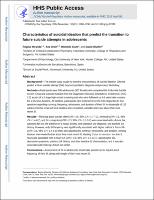Please use this identifier to cite or link to this item:
https://hdl.handle.net/20.500.12202/9636Full metadata record
| DC Field | Value | Language |
|---|---|---|
| dc.contributor.author | Miranda, Regina | - |
| dc.contributor.author | Ortin, Ana | - |
| dc.contributor.author | Scott, Michelle | - |
| dc.contributor.author | Shaffer, David | - |
| dc.date.accessioned | 2023-12-13T16:52:42Z | - |
| dc.date.available | 2023-12-13T16:52:42Z | - |
| dc.date.issued | 2014 | - |
| dc.identifier.citation | Miranda, R., Ortin, A., Scott, M., & Shaffer, D. (2014). Characteristics of suicidal ideation that predict the transition to future suicide attempts in adolescents. Journal of Child Psychology and Psychiatry, 55(11), 1288. | en_US |
| dc.identifier.issn | 0021-9630 | - |
| dc.identifier.uri | https://hdl.handle.net/20.500.12202/9636 | - |
| dc.description | Scholarly article / Open access | en_US |
| dc.description.abstract | __Background—The present study sought to examine characteristics of suicidal ideation (SI) that predict a future suicide attempt (SA), beyond psychiatric diagnosis and previous SA history. __Methods—Participants were 506 adolescents (307 female) who completed the Columbia Suicide Screen (CSS) and selected modules from the Diagnostic Interview Schedule for Children (C-DISC 2.3) as part of a 2-stage high-school screening and who were followed up 4-6 years later to assess for a SA since baseline. At baseline, participants who endorsed SI on the CSS responded to four questions regarding currency, frequency, seriousness, and duration of their SI. A subsample of 122 adolescents that endorsed SI at baseline also completed a detailed interview about their most recent SI. __Results—Thinking about suicide often (OR = 3.5, 95% CI = 1.7-7.2), seriously (OR = 3.1, 95% CI = 1.4-6.7), and for a long time (OR = 2.3, 95% CI = 1.1-5.2) were associated with a future SA, adjusting for sex, the presence of a mood, anxiety, and substance use diagnosis, and baseline SA history. However, only SI frequency was significantly associated with higher odds of a future SA (OR = 3.6, 95% CI = 1.4-9.1) when also adjusting for currency, seriousness, and duration. Among ideators interviewed further about their most recent SI, ideating 1 hour or more (vs. less than 1 hour) was associated with a future SA (OR = 3.6, 95% CI = 1.0-12.7), adjusting for sex, depressive symptoms, previous SA history, and other baseline SI characteristics, and it was also associated with making a future SA earlier. __Conclusions—Assessments of SI in adolescents should take special care to inquire about frequency of their SI, along with length of their most recent SI. | en_US |
| dc.description.sponsorship | __Acknowledgments__ This work was funded by grant R49/CCR 202598 from the Centers for Disease Control, NIMH grants P30 MH 43878 and ST32MH-16434, and grants from the American Mental Health Foundation and the Carmel Hill Foundation, to D.S. | en_US |
| dc.language.iso | en_US | en_US |
| dc.publisher | Wiley Subscription Services, Inc. | en_US |
| dc.relation.ispartofseries | Journal of Child Psychology and Psychiatry;55(11) | - |
| dc.rights | Attribution-NonCommercial-NoDerivs 3.0 United States | * |
| dc.rights.uri | http://creativecommons.org/licenses/by-nc-nd/3.0/us/ | * |
| dc.subject | Analysis | en_US |
| dc.subject | Suicidal ideation -- Analysis | en_US |
| dc.subject | Suicidal behavior -- Research | en_US |
| dc.subject | High risk children -- Care and treatment Research | en_US |
| dc.subject | Care and treatment | en_US |
| dc.title | Characteristics of suicidal ideation that predict the transition to future suicide attempts in adolescents. | en_US |
| dc.type | Article | en_US |
| dc.identifier.doi | https://doi.org/10.1111/jcpp.12245 | en_US |
| dc.contributor.orcid | 0000-0003-0825-6003 | en_US |
| local.yu.facultypage | https://www.einsteinmed.edu/faculty/17519/ana-ortin-peralta/ | en_US |
| Appears in Collections: | Ferkauf Graduate School of Psychology: Faculty Publications | |
Files in This Item:
| File | Description | Size | Format | |
|---|---|---|---|---|
| Ortin 2014 OA Characteristics of suicidal nihms-583037.pdf | 466.37 kB | Adobe PDF |  View/Open |
This item is licensed under a Creative Commons License

